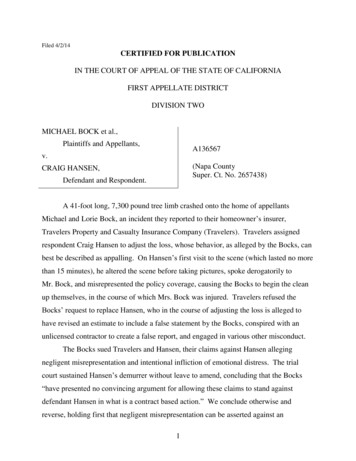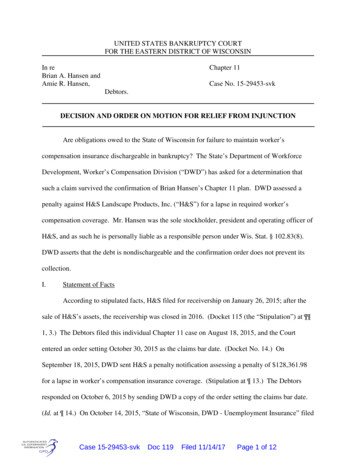
Transcription
Elliptic Curve CryptographyChristine Alar, Kyle Hansen, Cooper YoungMarch 2021
Contents1 Overview of Cryptography1.1 Introduction . . . . . . . . . . . . . . . . . . . . . . . . . . . . . . . . . . . . . . . . . . . . . .1.2 Diffie-Hellman Key Exchange . . . . . . . . . . . . . . . . . . . . . . . . . . . . . . . . . . . .3332 Elliptic Curves in Cryptography2.1 ECDH Protocol . . . . . . . . . . . . . . . . . . . . . . . . . . . . . . . . . . . . . . . . . . . .2.2 ECDH Example . . . . . . . . . . . . . . . . . . . . . . . . . . . . . . . . . . . . . . . . . . . .2.3 ECDSA Protocol . . . . . . . . . . . . . . . . . . . . . . . . . . . . . . . . . . . . . . . . . . .66793 Security3.1 DLP and ECDLP . . . . . . . . . . . . . . . . . . . . . . . . . . . . . . . . . . . . . . . . . . .3.2 ECDHP: Applying ECDLP to ECDH . . . . . . . . . . . . . . . . . . . . . . . . . . . . . . .3.3 Hardness of ECDLP, and #E(F) . . . . . . . . . . . . . . . . . . . . . . . . . . . . . . . . . .111112134 Vulnerabilities4.1 Pohlig-Hellman Attack . . . .4.2 Baby Step, Giant Step Attack4.3 Birthday Attacks . . . . . . .4.4 Other Attacks . . . . . . . . .14141616175 Comparison with other Algorithms5.1 ECDH and DH . . . . . . . . . . . . . . . . . . . . . . . . . . . . . . . . . . . . . . . . . . . .5.2 ECDH and RSA . . . . . . . . . . . . . . . . . . . . . . . . . . . . . . . . . . . . . . . . . . .5.3 ECDH and SIDH . . . . . . . . . . . . . . . . . . . . . . . . . . . . . . . . . . . . . . . . . . .18181818.2.
1 Overview of Cryptography1.1 IntroductionWhen sending a message online, how do we make sure that the message is not intercepted and read by athird party? Cryptography is the study and practice of techniques to keep communication secure from beingaccessed by third parties.In this paper, we discuss how elliptic curves can be used to ensure communication is secure over a publicdomain using the Elliptic-curve Diffie-Hellman (ECDH) key exchange, as well as its vulnerabilities andcomparisons with other algorithms.We first introduce the Diffie-Hellman key exchange, and several relevant definitions.1.2 Diffie-Hellman Key ExchangeA few quick definitions: cryptographic key: a string of characters used to convert a message to cipher text, or vice versa cipher text: the encrypted form of a message insecure channel: a way of transferring data that is subject to eavesdroppingThe Diffie Hellman (DH) key exchange is a method of securely exchanging cryptographic keys over a publicchannel. Originally, two correspondents needed to exchange keys via some secure physical method, and DHwas one of the first methods to allow two correspondents without prior contact to create a shared secret keyover an insecure channel.We begin with an analogy using paints to introduce the concept of Diffie-Hellman.Alice and Bob publicly agree on an arbitrary starting color (yellow). Alice adds her secret color (red) to herown paint can to make an orange mixture, and Bob adds his secret color (teal) to his can to make a bluemixture. The two exchange their paint cans publicly, and then add their secret color to the delivered paintcan. They each end up with a common secret paint color (brown).3
1.2. DIFFIE-HELLMAN KEY EXCHANGECHAPTER 1. OVERVIEW OF CRYPTOGRAPHYFigure 1.1: Diffie-Hellman paint analogy.A third party witnessing this exchange, although witnessing the common starting color and transportedmixtures, would have a difficult time determining the final secret color.We next introduce the original implementation of Diffie-Hellman which uses multiplication of integers moduloa prime p, and a primitive root modulo p denoted by g. [2]Say Alice and Bob publicly agree on a prime p and primitive root g.Alice then chooses a secret integer a and calculates A (g a mod p), while Bob chooses a secret integer b andcalculates B (g b mod p).Over a public channel, Alice sends Bob A and Bob sends Alice B.Alice now calculates B a (g b )a g ba mod p while Bob calculates Ab (g a )b g ab mod p, and sinceg ab g ba mod p, the two end up with a common secret number.Example 1.1. Let p 29 and g 8, a primitive root modulo 29.Say Alice chooses a 4 and Bob chooses b 3.Then Alice calculates g a mod p: 84 7 mod 29.Bob calculates g b mod p: 83 19 mod 29.Publicly, Alice and Bob exchange the values A 7 and B 19.Now Alice calculates B a mod p: 194 24 mod 29.Bob calculates Ab mod p: 73 24 mod 29.4
CHAPTER 1. OVERVIEW OF CRYPTOGRAPHY1.2. DIFFIE-HELLMAN KEY EXCHANGEAs shown above, the two end with the common secret number 24.4The publicly known values are p, g, g a , and g b . Just knowing these values, it takes extremely long times tocompute g ab mod p g ba mod p by any known algorithms, which is what gives strength to this method.It should be noted that the above example is not particularly secure since there are only 29 possible solutionsto n mod 29. To make this method secure we need to choose large values for a, b, and p. However, it isknown that for p a prime that is at least 600 digits then even "the fastest modern computers using the fastestknown algorithm cannot find a given only g, p, and g a mod p." [3] This problem, known as the discretelogarithm problem, will be discussed further in Chapter 3.5
2 Elliptic Curves in CryptographyIn this chapter we’ll explore two ways that elliptic curves are used in cryptography. The first is the EllipticCurve Diffie-Hellman, which is a protocol that establishes a shared key over an insecure channel. The secondis the Elliptic Curve Digital Signature Algorithm, which is used to authenticate digital content.2.1 ECDH ProtocolElliptic curve cryptography seeks to exploit the group structure of elliptic curves over finite fields to generatekeys for asymmetric cryptography. One of the most prominent ways that this is done is through the EllipticCurve Diffie-Hellman (ECDH) protocol; two parties, Alice and Bob, start with a public elliptic curve E :y 2 x3 ax b, a prime p, and a generating point G on E which has a large order. Alice and Bob bothhave a private keys which take the form nA , nB Z 0 , respectively. The protocol then proceeds as followsAlice: generates her public key by computingnA G (adding the generator to itself nA times).Bob: computes his public key, nB G.[The two exchange public keys.]Alice: determines the shared key by computing nA (Bob’s secret key).Bob: determines the shared key by computingnB (Alices’s secret key).By the end of this procedure, Alice and Bob have the same shared key since nA (nB G) (nA nB )G nB (nA G). The pair can now utilize symmetric key algorithms to encrypt and decrypt text or other forms ofinformation that they wish to send to one another.The security of ECDH comes from the fact that given the public information and a point nG, it is difficult todetermine the integer n. This is explored more fully in Chapter 3, but for intuition, let’s consider the ellipticcurve E : y 2 x3 7. This curve is referred to as the secp256k1 curve and become popular when Bitcoinstarted using it for their Elliptic Curve Digital Signature Algorithm (ECDSA). Over the finite field F17 , ourcurve looks like this6
CHAPTER 2. ELLIPTIC CURVES IN CRYPTOGRAPHY2.2. ECDH EXAMPLEFigure 2.1: secp256k1 over F17When we start with the generating point G (15, 13) E, we can label the points as followsFigure 2.2: G generates all points on EAs we can see, given some point nG E, it’s not easy to determine which n led to that point. Furthermore,the security of ECDH scales with the size of our prime p, and typically our prime is chosen to be 256 bitslong.The algorithm mirrors the typical Diffie-Hellman key exchange (DH), except it uses elliptic curve pointmultiplication instead of modular exponentiation. One benefit of using ECDH is that it is much less computationally expensive than DH. For example, according to the WebTrust-certified certificate authority providerGlobalSign, to match the security of a DH protocal with a 3000 bit key, one would need to use a prime ofonly 256 bits when using ECDH [9]. The security of ECDH will be explored in Chapter 3, but this fact alonegives credence to the benefit of elliptic curves in cryptography.2.2 ECDH ExampleNow that we have a working understanding of ECDH, let’s outline an implementation of it using python. Westart by importing the python library tinyec and preparing the curve "secp256r1."One of the main differences between secp256k1 and secp256r1 is that the former is a Koblitz curve while thelatter is not. That is, secp256k1 takes the form y 3 x3 ax b with a 0, while for secp256r1, neither anor b are trivial. In general, the etymology for an elliptic curve identifies useful characteristics of the curve.7
2.2. ECDH EXAMPLECHAPTER 2. ELLIPTIC CURVES IN CRYPTOGRAPHYFor example, "sec" in an elliptic curve’s names stands for "Standards for Efficient Cryptography," and whena curve starts with "secp," it means that it’s taken over a prime field Fp . Having a t in the name denotesthe base field takes the form F2n , having a k denotes a Koblitz curve, and an r denotes verifiably randomparameters.Our curve secp256r1 comes equipped with a generating pointand the 78-digit prime as seen when printing secp256r1 above. The SubGroup class in tinyec takes arguments(p, g, n, h) where p is the prime we are working over, g is the generating point, n is the order of g, and h is thecofactor (the cardinality of E(Fp ) divided by n) and the Curve class takes in arguments (a, b, f ield, name)where E : y 2 x3 ax b, f ield is the field we are working over, and name is the nickname we give thecurve. Hence, we could have also defined our curve by handNext, we import secrets, which is used to generate random numbers for Alice and Bob’s private keys.Finally, these public keys are exchanged, allowing Alice and Bob to have a shared key. Often times, it issecure enough to just use the x-coordinate of the computed point:8
CHAPTER 2. ELLIPTIC CURVES IN CRYPTOGRAPHY2.3. ECDSA PROTOCOLThis shared key can now be used in various symmetric-key algorithms to securely transfer information betweenAlice and Bob.2.3 ECDSA ProtocolAnother common use of elliptic curves in cryptography is through the Elliptic Curve Digital SignatureAlgorithm (ECDSA). The protocol has two parts: the signing and the verifying. Together, they show thatthe signer was the one who sent the message and that the message wasn’t altered in transit.Suppose Alice has some message, M , that she wants to send to Bob. She wants to show that she is the onethat sent M and make sure the message wasn’t altered before it got to Bob. Beforehand, the pair agree onan elliptic curve E, a generating point G, and the large prime order n for G. Alice has a private key in theform of a random integer dA [1, n 1], and a public key, dA G. The signing algorithm carried out by Aliceis as follows:Signing Algorithm1.) Compute h : HASH(M ), where HASH is a hash function like SHA-256 whose output is an integer2.) Generate a random integer k [1, n 1]3.) Calculate the point (x1 , y1 ) kG4.) Calculate r x1 (mod n) and s k 1 (z rdA ) (mod n)5.) Return the signature: (r, s)If either r or s is zero, we return to step 2 and compute a new random integer. Note that the reason werequire n to be prime is so that we are guaranteed the existence of k 1 in step 4. Once Alice has computedthe pair of integers (r, s), she sends the message M to Bob first and then the signature (r, s). Bob then usesthe verifying algorithm below, which outputs a boolean value representing if the signature is valid or notVerifying Algorithm1.) Check the validity of dA G by verifying it’s on E and n(dA G) O.2.) Compute h HASH(M ) with the same has function as in the signing algorithm3.) Calculate u1 hs 1 (mod n) and u2 rs 1 (mod n)9
2.3. ECDSA PROTOCOLCHAPTER 2. ELLIPTIC CURVES IN CRYPTOGRAPHY4.) Recover the point (x1 , y1 ) u1 G u2 QA5.) r x1 (mod n), the signature is valid, and it is invalid otherwiseIt’s not obvious why this verification works, but the key observation is that the point recovered in step 4 ofthe verifying algorithm is the same point computed in step 3 of the signing algorithm. To see this, noticethatu1 G u2 QA u1 G u2 dA G (u1 u2 dA )G (hs 1 rs 1 dA )G (h rdA )s 1 G (h rdA )(z rdA ) 1 kG kGIt’s worth noting that for the signing algorithm, a new random integer k must be used every time or elsesomeone could compute the private key dA ; suppose that Eve knows two signatures (r, s) and (r, s0 ) whichused the same k value to make certificates for the messages M and M 0 . First, Eve can compute the integerk by recalling that s k 1 (h rdA ) (mod n) and s0 k 1 (h0 rdA ) (mod n). These equations give uss s0 k 1 (h h0 ) (mod n)and from this we can recover k (h h0 )(s s0 ) 1 (mod n)dA r0 (sk h) (mod n)In 2010, a group noticed that Sony used a static k for their ECDSA and used the technique above to recoverthe private key that Sony used to sign software for their PlayStation 3 console. If different random integersk are generated for each signature, the technique is secure, and ECDSA is widely used today in the TLSprotocol by popular sites such as Wikipedia, YouTube, and Facebook. In fact, Facebook uses the secp256r1curve from the previous section for their ECDSA to generate a certificate during TLS.10
3 SecurityIt is a common occurrence that cryptographic systems find their security in mathematical problems which arehard to solve—that is, for which there is either no known deterministic algorithm which solves the problem,or for which any current deterministic algorithms are intractable, meaning that they require too much timeor space in order to operate efficiently and effectively. For example, there is currently no deterministicpolynomial-time algorithm which solves the problem of factoring (large) composite numbers [10]. Anothersuch problem which is hard to solve, and which is related to Elliptic Curve Cryptography, is known as the“Discrete Log Problem”, or DLP.3.1 DLP and ECDLPThe classical version of DLP can be described as follows:DLP:Fix a prime p. Given a, b Fp subject to the condition that b ax (mod p) for some x Z,determine the value of x. That is, compute the discrete logarithm La (b) x.This problem is hard, provided p is large enough. When p is small, one can perform a brute force search todetermine x. For example, given p 11, if a 2 and b 9, one can compute by brute force that 2x 9(mod 11) is solved by x 6. However, as long as the factorization of p 1 contains a large enough prime,this problem is resistant to the Pohlig-Hellman attack, and if p itself is large enough (say, p 1020 ), theproblem is resistant to so-called “Baby Step, Giant Step” attacks [10, 202,207]. We will encounter variationsof these attacks for Elliptic Curves in Section 4.1 and 4.2 respectively.There is an elliptic curve variation of this problem, appropriately named the “Elliptic Curve Discrete LogProblem”, or ECDLP, which is described as follows:ECDLP:Fix a finite field Fq for q pk with p prime, and an elliptic curve E/Fq . Given G, P E(Fq )subject to the condition that P nG for some n Z, determine the value of n. That is,compute the “elliptic curve discrete log” ELG (P ) n.The similarities with DLP are obvious, though the difficulty of solving ECDLP does not now depend only onthe choice of prime p, but rather on the finite field Fq , as well as on the choice of curve E/Fq . As will be seenin Section 3.3 and Chapter 4, these choices must be made carefully to ensure the hardness of ECDLP. In11
3.2. ECDHP: APPLYING ECDLP TO ECDHCHAPTER 3. SECURITYSection 5.1, we will see that, even though there is no proof that ECDLP is a computationally hard problem,such a proof would have tremendous implications for the theory of computation. Hence, ECDLP is considereda hard enough problem to provide cryptographic security.3.2 ECDHP: Applying ECDLP to ECDHBefore considering the difficulty of solving ECDLP, let us see how it is relevant in the context of ECDH.Recall the description of ECDH in Section 2.1, and consider things now from the perspective of the maliciouseavesdropper Eve. By assumption, Eve knows that Alice and Bob are using ECDH to create a shared keyK. Throughout the entire exchange, Eve is assumed to gain access to any information that is transmitted ormade public, and so in particular, Eve is assumed to have access to the following information:1.) The curve and finite field E/Fq ,2.) The generating point G E(Fq ),3.) The points computed by each of Alice and Bob, QA nA G and QB nB G respectively (which aretransmitted publicly during the key exchange)Alice and Bob each independently compute the shared key K nA nB G nB nA G from the informationgiven, as well as from the fact that the values nA and nB remain secret. If Eve could obtain a copy of thiskey K, then Eve to be able to eavesdrop on their correspondences which use that key. Hence, it is Eve’s goalto solve the following problem, known as the “Elliptic Curve Diffie-Hellman Problem”, or “ECDHP” for short:ECDHP:Fix a finite field Fq for q pk with prime p, and an elliptic curve E/Fq . Given G, QA , QB E(Fq ) subject to the condition that QA nA G and QB nB G for some nA , nB Z,determine the value of K nA nB G.With this setup in mind, we can make the following, straightforward claim:Proposition 3.1. ECDHP reduces to ECDLP.Proof. Suppose that Eve has solved ECDLP, and is listening in as above. Since she has access tothe points G and QA nA G, for example, she will be able to compute nA , since she has solvedECDPL. Then, because she also has access to QB nB G, she can compute nA QB nA nB G K.Thus, ECDLP reduces to ECDLP.Let’s return our attention to the curve sepc256k1 from Section 2.2, and for the sake of tractability, let’sconsider an example over a small finite field.Example 3.2. Alice and Bob have chosen to work with the curve sepc256k1 (i.e. E : y 2 x3 7) overthe finite field Fq F17 , with the generator G (15, 13) E(F17 ). During the key exchange, Eve seesthat Alice and Bob send the points QA (8, 3) and QB (10, 16) respectively. If she could solve ECDLP,Eve could compute K (12, 1) 4G using this information alone, and could then listen in on their futurecorrespondences.412
CHAPTER 3. SECURITY3.3. HARDNESS OF ECDLP, AND #E(F)3.3 Hardness of ECDLP, and #E(F)In selecting an elliptic curve E/Fq , along with a generating point G E(Fq ), over which to perform computations, one must be careful. The domain parameters of an elliptic curve scheme is a tuple of informationwhich allows one to test the security of the scheme in question. In particular, in addition to the curve andgenerating point, this tuple contains:1.) The order n of G,2.) The cofactor h : #E(Fq )/n.The hardness of ECDLP, and certain vulnerabilities of the scheme, depend on wise choices of curves thatguarantee the cofactor h is sufficiently small (typically h 4). However, one should also ask that n o(G) befairly large (e.g., at least n 2160 according to [4, 172]) to avoid certain attacks such as the Pohlig-Hellmanattack in Section 4.1, as will be seen later.Because of this, we see that choosing an elliptic curve scheme with the right domain parameters will dependon being able to count the number of points on the curve, in order to effectively compute h. Moreover,as will be seen in Chapter 4, knowing #E(Fq ) will help determine the runtime of certain algorithms whichattack ECDLP, and hence this parameter in particular is crucial for determining the security of the schemein question.Recall the following theorem of Hasse: Theorem 3.3 (Hasse, 1936). An elliptic curve E/Fq has #E(Fq ) q 1 t points where t 2 q.In general counting the number of points on a curve by direct methods (i.e. counting them one at a time)would be infeasible, and so it was a significant problem to find a polynomial-time algorithm which countsthe points on the curve in an efficient way. Hasse’s Theorem gives an estimate for the number of points onE, but does not give a way to determine exactly the number of points.However, more recently Schoof’s Algorithm (1985) provides a polynomial-time, deterministic algorithm forcomputing t given any elliptic curve E/Fq . Though the exact description of this algorithm and its runtime isbeyond the scope of this paper, the main ideas make use of the the Frobenius Endomorphism ϕ : E/Fq E/Fqdefined by ϕ(x : y : z) (xq : y q : z q ). In fact, the brunt of the proof relies on showing one can computethe trace trϕ (mod l) efficiently for enough primes l. Combining these results with the Chinese RemainderTheorem (in a manner similar to that seen later in Section 4.1) one can then compute the value of t #E(Fq )efficiently. For an in-depth description of Schoof’s Algorithm and its applications, we direct readers to [6]and [1, 109 ff].The main benefit to Schoof’s Algorithm (and the various improvements to the algorithm which have beendeveloped since Schoof’s breakthrough) is that one has a feasible method for computing the number of pointson a curve, and hence one can compute domain parameters for curves efficiently as well. This allows usto more efficiently classify curves according their cryptographic security. For a list of some such acceptablecurves, we refer the reader to FIPS recommended curves [8, 89 ff].13
4 VulnerabilitiesIn this section, we discuss various attacks that might be made against cryptosystems which employ ellipticcurve cryptography. Each of these attacks have analogues in standard (non-elliptic curve based) cryptosystems. However, elliptic curve based cryptography has an added advantage of being resistant to what areknown as “index-calculus” attacks, a well-known attack in standard cryptosystems (see [4, 165 ff] for details).The point of this section is not to dissuade use of elliptic curve cryptography, but rather to highlight theimportance of using curves with “good” domain parameters, and following conventions such as those laid outthe ANSI Standard [11, 14-18].In what follows, we assume the following conventions, as in the description of ECDLP: E : y 2 x3 ax b is an elliptic curve over Fq G E(Fq ) is a point of order n o(G) P αG for some α Z #E(Fq ) is the number of points on the curve h : #E(Fq )/o(G) is called the cofactorFor pseudo-code algorithms implementing following attacks, and others, we direct readers to [4, 155 ff].There are also attacks (e.g. “Person-in-the-Middle Attacks”) which deal more with implementation ratherthan mathematical security, and as such their discussion is beyond the scope of this paper.4.1 Pohlig-Hellman AttackWhen n o(G) is composed only of “small” prime factors, there is an attack known as the Pohlig-Hellmanattack which exploits this weakness. A classical version of the Pohlig-Hellman attack on DLP is outlined in[10, 203], the ideas behind which have a natural analogue in ECDLP (as seen in [4, 155]). We explain thisElliptic Curve variation here.The main idea is that, given the generator G and a point Q hGi, one can compute the value of α (mod pm )efficiently for small primes p and powers m N, and then recombine these results using the Chinese RemainderTheorem. We outline this procedure for p 2, followed by the more general situation.14
CHAPTER 4. VULNERABILITIES4.1. POHLIG-HELLMAN ATTACKFirst, suppose that 2 n, so that 2m G O (the additive identity on E) for some m N, and that 2m 1 G 6 O.Without loss of generality, we may assume 0 α 2m . Writing α as its binary expansionα m 1X2 i xi(xi {0, 1} , i 0, 1, . . . , m 1)i 0one can see that x0 0 if and only if 2m 1 Q O, since o(G) 2m . Inductively, suppose that the values ofx0 , . . . , xr 1 have been determined for some r m. Define!!!r 1m 1m r 1XXXiir 1iQr : Q 2 xi G 2 xi G 22 xi r G.i 0i ri 0Then since xr 0 if and only if 2Qr O, one can compute xr iteratively by testing if 2m r 1 Qr O,mand hence one can compute α (mod 2 ).m r 1More generally, given a (small) prime p for which p n, we may write pm G nG O for some m N.Writing α in its base-p expansionα m 1Xpi xi(xi {0, . . . , p 1} , i 0, 1, . . . , m 1)i 0(p)define Q0 : Q, and for each 0 r m 1 define!!r 1m 1XX(p)iiQr : Q p xi G p xi G p ri 0i rm r 1X!ip xi rG.i 0 (p)Note then by construction that pm r 1 Qr xr pm 1 G , since pm G O. Hence, our attack reduces to (p)determining which value xr {0, . . . , p 1} is such that xr pm 1 G pm r 1 Qr . For small enough p,(p)brute force computations and searches make this appraoch feasible. Thus one can compute xr using Qr(p)mand then inductively compute Qr 1 using x0 , . . . , xr . We can therefore determine the value of α (mod p )in this iterative fashion.ms1 m2This process demonstrates that if n pmis the prime factorization of n, one can determine1 p2 · · · psmrthe values α αr (mod pr ) for each r s efficiently, provided the primes pr are small enough. By theChinese Remainder Theorem, there is a unique solution to this system of relations, and there is an efficient,deterministic algorithm for computing this solution. So one can reconstruct α using these relations, and thusdetermine ELG (P ) α.In the following example, we use the notationnprin place of pm r as above.Example 4.1. Let E/F37 be the curve E : y 2 x3 x 4. Let G (25, 15), and consider Q (6, 2) hGi.Note that n o(G) 28 22 · 7, and write Q αG. Our goal is to determine the value of α.α (mod 4): First write α x0 2x1 (mod 4). We see that x0 1, sincen (2)2 Q0(2)Q1 14Q (19, 0) 6 O. Next,we write Q x0 G Q G (6, 2) (25, 22) (15, 8). Since 7(15, 8) x1 0. Therefore we conclude that α x0 2x1 1 (mod 4).α (mod 7): Now, write α y0 (mod 7), its base-7 expansion. Sincey0 such thaty0 ( np G) n (7)p Q0 ,n (7)p Q0(2)n22 Q1 O, we have 4Q (15, 8), we seek to findwhich is to say, such that y0 (4G) (15, 8). Since 4G (3, 21) we want15
4.2. BABY STEP, GIANT STEP ATTACKCHAPTER 4. VULNERABILITIESa value 0 y0 7 for which y0 (3, 21) (15, 8). One can compute that y0 2 gives the desired result,and hence α 2 (mod 7).Therefore, α 1 (mod 4) and α 2 (mod 7), which implies by the Chinese Remainder Theorem that wehave α 9 (mod 28). One can check that indeed (6, 2) 9(25, 15).4The effectiveness of this attack depends entirely on the fact that n is divisible only by small primes. If nhas even one prime factor that is large enough, the computations become exceedingly difficult to performefficiently, and the attack becomes unusable.4.2 Baby Step, Giant Step AttackAnother deterministic algorithm, dependent on the order n of G, is that known as the “Baby Step, GiantStep” (or BSGS) attack. Again, the idea stems from a classical attack on DLP, which has an analogue inECDLP. We examine this analogue below.The idea behind this attack is that, given the points G and P αG, create two lists of size N for whichN 2 n o(G) as follows:1.) A list of values βG for 0 β N , the “baby steps”,2.) A list of values P N γG for 0 γ N , the “giant steps”.If there is a match between the lists, we have some values β, γ N such that βG P N γG, and henceP (β N γ)G so that α β N γ. Note that such a match will always exist by the fact that N 2 n.Hence this algorithm is guaranteed to terminate. The most obvious failing on the part of this algorithm is thefact that it requires tremendous amounts of memory (on the order of n for each list), which is intractablefor large enough n. Though the attack is guaranteed to eventually terminate, it can be thwarted simply bychoosing good parameters (e.g., such that n is large enough).4.3 Birthday AttacksAn attack similar to that of the BSGS attack is known as a “Birthday” Attack. The method of attack isessentially the same as that of the BSGS attack in Section 4.2 above, but with the significant difference thatinstead of computing both lists for all values of 0 β N and 0 γ N , one computes two lists of randomvalues for some “large enough” N . Namely, one computes the following two lists, where N is a large value:1.) A list of values βG for N randomly chosen values of β2.) A list of values P nγG for N randomly chosen values of γBy the same token as in the BSGS attack, if a match occurs in these two lists, one can successfully computeα β nγ. The advantage to this attack over BSGS, is that by nature, it uses less memory, when N isselected so that N 2 n.On the other hand, there is no guarantee that the process of the Birthday Attack terminates. Instead, thisalgorithm is probabilistic, in that there is a high probability a collision between the two lists occurs. Thisprobability is computed using the same methods as the well-known “birthday paradox” (hence the name16
CHAPTER 4. VULNERABILITIES4.4. OTHER ATTACKS“birthday attack”) which explains, for example, the phenomenon that given a random selection of 23 people,there is about a 50% probability two of them have the same birthday.Another advantage of using BSGS attacks over a birthday attack is that typically computations of points ofthe form βG or P nγG can be simplified by processes such as a point doubling formula, or using previouslycomputed points in some other way. Because of this, Birthday Attacks tend to be slower, and, though itmay seem that the space-time trade-off could balance out, BSGS attacks end up being somewhat superior toBirthday attacks [10, 232].4.4 Other AttacksOther attacks (such as Weil and Tate Pairing Attacks, attacks exploiting Weil Descent, and attacks onprime-field-anomalous curves) make use of the fact that points of the form P αG are elements of the cyclicsubgr
There is an elliptic curve variation of this problem, appropriately named the "Elliptic Curve Discrete Log Problem",orECDLP,whichisdescribedasfollows: ECDLP: FixafinitefieldF q forq pk withpprime,andanellipticcurveE F q. GivenG;P2E(F q) subject to the condition that P nGfor some n2Z, determine the value of n. That is,










